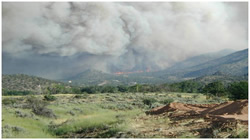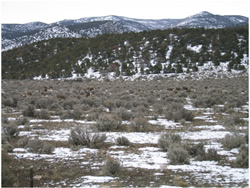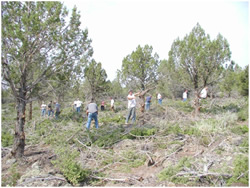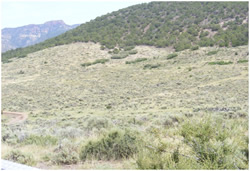Forests and Rangelands Success Story
Utah DWR and BLM Partnership Proves Paramount for Wildland Urban Interface Communities
Utah
National Fire Plan - Fuels Reduction
2008

The Blue Springs Wildfire is one of four major fires that have threatened New Harmony, Utah since 2005.

Wintering Mule deer feeding on sage brush near dedicated hunter projects along the Parowan Front in southern Utah.

Several volunteers from the UDWR’s Dedicated Hunter Program perform mechanical thinning to reduce hazardous fuels along the I-15 corridor, near New Harmony, Utah.

Fuels reduction maintenance in critical mule deer habitat project completed jointly by BLM fire crews and volunteers of the UDWR’s Dedicated Hunter Program just south of Parowan, Utah.
On May 18, 2001, the Color Country Interagency Fuels Committee identified six critical focus areas for implementation of hazardous fuels reduction projects. One of the six focus areas was the Black Ridge, New Harmony area. Historically, this area has experienced a large amount of urban growth and has been consistently threatened by large fires. As in most of the western United States, pinion and juniper trees have increased dramatically in recent decades. The encroachment of these species into areas not traditionally occupied, results in a dangerous hazardous fuel load, adjacent to communities. At the same time, the trees out compete browse species that are the critical food source for wintering mule deer and increase the risk of habitat loss from fire.
The Bureau of Land Management, U.S. Forest Service, Utah Forestry Fire and State Lands, and the Utah Division of Wildlife Resources aggressively put a master fuels reduction plan into action to conduct hazardous fuels reduction work on a collaborative, landscape level, rather than accomplishing small and less effective treatments individually. The result has been the creation of roughly 2,500 acres (approximately six miles) of vegetation treatments that not only reduce the risk from wildland fire to the growing communities, but enhance habitat for wildlife as well.
The Bureau of Land Management (BLM) Color Country District, and Utah Division of Wildlife Resources (UDWR), Southern Region’s Dedicated Hunter Program, established in 1995, have combined efforts to promote hazardous fuels reduction work in various urban interface areas of southern Utah, Beaver, Parowan, New Harmony, Enterprise, Central, and Dammeron Valley, Utah, to name a few. Although the Dedicated Hunter Program has the primary objective of improving wildlife habitat and promoting good conservation practices, the volunteer program also assists the BLM in protecting communities at risk from wildfire through mechanical thinning efforts.
Over 3,000 dedicated hunters from Washington, Iron, Beaver, Kane, and Garfield counties have worked on vegetation management projects on BLM lands through the volunteer services department of UDWR to fulfill program requirements. Heather Perry, volunteer services coordinator for the DWR Southern Region, coordinates volunteer work efforts in southern Utah with hunters who need the required 24, pre-approved work hours within a three-year period. Hours are mandatory in order for individual hunters to meet program requirements. The program enables hunters to obtain two Mule Deer hunting tags within a three-year period and offers various learning opportunities for interested hunters.
"We have common natural resource management interests with the BLM, like winter range habitat for mule deer in the lower sage brush areas," said Perry. "We have completed 2,800 volunteer work hours and over $48,000 in volunteer labor costs on BLM lands since 2007 with the dedicated hunter program" Perry stated. To date, mechanical thinning efforts by BLM personnel and dedicated hunters have collectively treated approximately 2,000 acres of BLM lands within and adjacent to communities at risk from wildfire. By proactively managing the landscape, we are able to retain the views and values that make this such a great place to live. Volunteer laborers from the Utah Division of Wildlife Resources Dedicated Hunter Program have been instrumental in the implementation and maintenance of these projects.
This partnership effort is considered a major success and is expected to continue, the state of Utah’s DWR Dedicated Hunter Program reached its cap of 10,000 members in 2008.
Contact: Paul Briggs at (435) 865-3002.